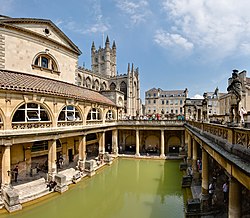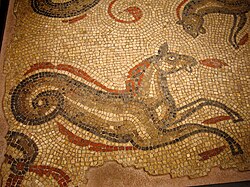Roman Baths, Bath
| The Roman Baths | |
|
Somerset | |
|---|---|
 The Roman Baths in the city of Bath, England | |
| Location | |
| Grid reference: | ST75076471 |
| Location: | 51°22’51"N, 2°21’34"W |
| City: | Bath |
| History | |
| Built 1st century / 1894-1897 | |
| By: | John Brydon |
| Information | |
The Roman Baths are a well-preserved thermae in the city of Bath in Somerset.
A temple was constructed on the site between AD 60-70 in the first few decades of Roman Britain. Its presence led to the development of the small Roman urban settlement known as Aquae Sulis around the site. The Roman baths—designed for public bathing—were used until the end of Roman rule in Britain in the 5th Century AD. An Anglo-Saxon poem describes the original Roman city and baths as being in ruins a century later. The area around the natural springs was redeveloped several times during the Early and Late Middle Ages.
The Roman Baths are preserved in four main features: the Sacred Spring, the Roman Temple, the Roman Bath House, and a museum which holds artefacts from Aquae Sulis. The bath itself and the footings of the pillars are all original Roman work, but above these, the buildings at street level date from the 19th century. It is a major tourist attraction and, together with the Grand Pump Room, receives more than 1.3 million visitors annually.[1] Visitors can tour the baths and museum but cannot enter the water.
The bath house is a Grade I listed building.[2]
Hot spring
The water is sourced from rainfall on the nearby Mendip Hills, which then percolates down through limestone aquifers to a depth of between 9,000 feet and 14,000 feet. Geothermal energy raises the water temperature here to between 69°C and 96°C. Under pressure, the heated water rises along fissures and faults in the limestone, until it bubbles up from the ground into the baths. This process is similar to an enhanced geothermal system, which also makes use of the high pressures and temperatures below the earth's crust. Hot water at a temperature of 46°C rises here at the rate of 260,000 gallons every day, from a geological fault (the Pennyquick fault). In 1982 a new spa water bore-hole was sunk, providing a clean and safe supply of spa water for drinking in the Pump Room.
Water quality
Bath was charged with responsibility for the hot springs in a Royal Charter of 1591 granted by Elizabeth I. This duty has now passed to the local council, who monitor pressure, temperature and flow rates. The thermal waters contain sodium, calcium, chloride and sulphate ions in high concentrations.
The Roman Baths are no longer used for bathing. In October 1978, a young girl swimming in the restored Roman Bath with the Bath Dolphins, a local swimming club, contracted meningitis and died,[3] leading to the closure of the bath for several years.[4] Tests showed Naegleria fowleri, a deadly pathogen, in the water.[5] The newly constructed Thermae Bath Spa nearby, and the refurbished Cross Bath, allow modern-day bathers to experience the waters by way of a series of more recently drilled boreholes.
History

Archaeological evidence indicates that the site of the baths may have been a centre of worship used by Celts; the springs were dedicated to the goddess Sulis, whom the Romans identified with Minerva. Geoffrey of Monmouth in his largely fictional Historia Regum Britanniae describes how the spring was discovered by the pre-Roman British king Bladud who built the baths there.[6] Early in the 18th century Geoffrey's obscure legend was given great prominence as a royal endorsement of the waters' qualities, with the embellishment that the spring had cured Bladud and his herd of pigs of leprosy through wallowing in the warm mud.[7]
Roman Britain
The name Suliis continued to be used after the Roman invasion, leading to the town's Roman name of Aquae Sulis ("the waters of Sulis"). The temple was constructed in 60–70 AD and the bathing complex was gradually built up over the next 300 years. During the Roman occupation of Britain, and possibly on the instructions of Emperor Claudius, engineers drove oak piles to provide a stable foundation into the mud and surrounded the spring with an irregular stone chamber lined with lead. In the 2nd century it was enclosed within a wooden barrel-vaulted building, and included the caldarium (hot bath), tepidarium (lukewarm bath), and frigidarium (cold bath).[8]
About 130 curse tablets have been found. Many of the curses are related to thefts of clothes whilst the victim was bathing.[9]
After the Roman withdrawal from Britain in the first decade of the 5th century, these baths fell into disrepair and were eventually lost due to silting up,[10] and flooding.[11]
The Anglo-Saxon Chronicle records that the West Saxons captured Baþanceaster from the Britons by in 577. An Anglo-Saxon poem known as "The Ruin" suggests the original Roman baths were left ruinous.[12]
Post-Roman use

The baths have been modified on several occasions, including the 12th century, when John of Tours built a curative bath over the King's Spring reservoir, and the 16th century, when the city corporation built a new bath (Queen's Bath) to the south of the spring. The court physician Théodore de Mayerne bathed Anne of Denmark in the King's Bath on 19 May 1613. She returned in August 1615.[13] Anne of Denmark was surprised by a flame caused by natural gas in King's Bath, and thereafter used the New Bath or Queen's Bath where a column with a crown and the inscription "Anna Regnum Sacrum" was added in her honour.[14]
The spring is now housed in 18th-century buildings, designed by architects John Wood, the Elder and John Wood, the Younger, father and son. Visitors drank the waters in the Grand Pump Room, Bath|Grand Pump Room, a neo-classical salon which remains in use, both for taking the waters and for social functions. Victorian expansion of the baths complex followed the neo-classical tradition established by the Woods. In 1810 the hot springs failed and William Smith opened up the Hot Bath Spring to the bottom, where he found that the spring had not failed but had flowed into a new channel. Smith restored the water to its original course.
The visitor entrance is via an 1897 concert hall by J. M. Brydon. It is an eastward continuation of the Grand Pump Room, with a glass-domed centre and single-storey radiused corner.
The Grand Pump Room was begun in 1789 by Thomas Baldwin. He resigned in 1791 and John Palmer continued the scheme through to completion in 1799. The elevation on to Abbey Church Yard has a centre piece of four engaged Corinthian columns with entablatures and pediment. It has been designated a Grade I listed building.[2]
The north colonnade was also designed by Thomas Baldwin. The south colonnade is similar but had an upper floor added in the late 19th century.
The museum and Queen's Bath including the "Bridge" spanning York Street to the City Laundry were by Charles Edward Davis in 1889. It comprises a southward extension to the Grand Pump Room, within which some parts of the 17th-century Queen's Bath remain.
Museum

The museum houses artefacts from the Roman period including objects that were thrown into the Sacred Spring, presumably as offerings to the goddess. These include more than 12,000 denari coins, which is the largest collective votive deposit known from Britain. A gilt bronze head of the goddess Sulis Minerva, which was discovered nearby in 1727, is displayed.
The Bath Roman Temple stood on a podium more than six feet above the surrounding courtyard, approached by a flight of steps. On the approach there were four large, fluted Corinthian columns supporting a frieze and decorated pediment above. The pediment, parts of which are displayed in the museum, is the triangular ornamental section, 26 feet wide and 8 feet from the apex to the bottom,[15] above the pillars on the front of the building. It featured the powerful central image of a possible "Gorgon" head glowering down from a height of 50 feet on all who approached the temple. The great head itself has snakes entwined within its beard, wings above its ears, beetling brows and a heavy moustache[16] although there is some controversy about what this really represents, as Gorgons are usually female. An alternative interpretation sees the central head as the image of a water god such as Oceanus,[17] and yet another as a Celtic sun god.[8] In early 2010 various stones on the pediment were conserved and rearranged.[18]
Also on display are the remains of the elaborate hypocaust heating system, which served the sweat rooms.
Preservation

The late 19th century carvings of Roman Emperors and Governors of Roman Britain on the terrace overlooking the Great Bath are particularly susceptible to the effect of acid rain and are protected with a wash of a sacrificial shelter coat every few years.[19] Exhibits within the temple precincts are susceptible to warm air which had the effect of drawing corrosive salts out of the Roman stonework. To help reduce this, a new ventilation system was installed in 2006.
Pictures
-
Bath Abbey West front, Roman Baths and Pump Room
-
Great Bath
-
The 'sacred pool'
-
Hippocamp mosaic
-
Spring overflow
-
Frigidarium (cold pool)
-
Model of Roman Bath and Temple as they would have looked at their greatest extent in 4th century AD
-
Model of Roman Bath
-
Bladud Gorgon head
-
Circular Bath (Caldaria)
-
19th century ceiling
-
Caldarium, with the floor removed to reveal the empty space which the hot air flowed through to heat the floor
Outside links
| ("Wikimedia Commons" has material about Roman Baths, Bath) |
References
- ↑ ALVA - Association of Leading Visitor Attractions
- ↑ Jump up to: 2.0 2.1 National Heritage List 1394021: Roman Baths Museum (Grade I listing)
- ↑ "History of Bath's Spa". Bath Tourism. http://visitbath.co.uk/spa-and-wellbeing/history-of-baths-spa.
- ↑ Crowther, Nigel B. (2007). Sport in Ancient Times. Greenwood Publishing Group. p. 98. ISBN 9780275987398. https://books.google.com/books?id=whvJtfTSd04C&pg=PA98. Retrieved 9 January 2013.
- ↑ Kilvington, Simon; Beeching, John (June 1995). "Identification and epidemiological typing of Naegleria fowleri with DNA probes". Applied and Environmental Microbiology 61 (6): 2071–2078. doi:10.1128/AEM.61.6.2071-2078.1995. PMID 7793928.
- ↑ Geoffrey of Monmouth (1966). The History of the Kings of Britain. Harmondsworth, England: Penguin. p. 80. ISBN 0-14-044170-0. https://archive.org/details/historyofkingsof00geof/page/80.
- ↑ Borsay, Peter (2000). The Image of Georgian Bath, 1700-2000. Oxford, England: Oxford University Press. pp. 49–55. ISBN 0-19-820265-2.
- ↑ Jump up to: 8.0 8.1 "The Roman Baths". TimeTravel Britain. http://www.timetravel-britain.com/05/April/romanbaths.shtml.
- ↑ Roger Tomlin (1988), Tabellae Sulis: Roman inscribed tablets of tin and lead from the sacred spring at Bath, Oxford.
- ↑ "The Roman Baths". BirminghamUk.com. http://www.birminghamuk.com/romanbaths.htm.
- ↑ Havinden, Michael (1981). The Somerset Landscape. The making of the English landscape. London: Hodder and Stoughton. p. 67. ISBN 0-340-20116-9.
- ↑ Bayley, Stephen (September 2007). "Is Bath Britain's most backward city?". The Observer. http://arts.guardian.co.uk/art/architecture/story/0,,2170069,00.html. Retrieved 1 November 2007.
- ↑ William Shaw & G. Dyfnallt Owen, HMC 77 Viscount De L'Isle Penshurst, vol. 5 (London, 1961), p. 307.
- ↑ John Nichols, Progresses of James the First, vol. 2 (London, 1828), pp. 640, 643.
- ↑ Richmond, I. A.; Toynbee, J. M. C. (1955). "The Temple of Sulis-Minerva at Bath". The Journal of Roman Studies (The Journal of Roman Studies, Vol. 45) 45: 97–105. doi:10.2307/298749.
- ↑ "New addition to Gorgon's head". Bath and North East Somerset Council. http://www.bathnes.gov.uk/BathNES/media/press+releases/2006/lifeandleisure/New+addition+to+Gorgons+head.htm.
- ↑ "Key objects of the collection". Roman Baths Museum. http://www.romanbaths.co.uk/key-objects-collection.
- ↑ "Bath Roman Baths repairs by Minerva". Minerva Stone Conservation. http://www.minervaconservation.com/projects/bath.htm.
- ↑ "Conserving the monument". Roman Baths Museum Web Site. http://www.romanbaths.co.uk/index.cfm?fuseAction=SM.nav&UUID=3F37CDAD-E666-49BD-9AA8FC1D739985F8.











